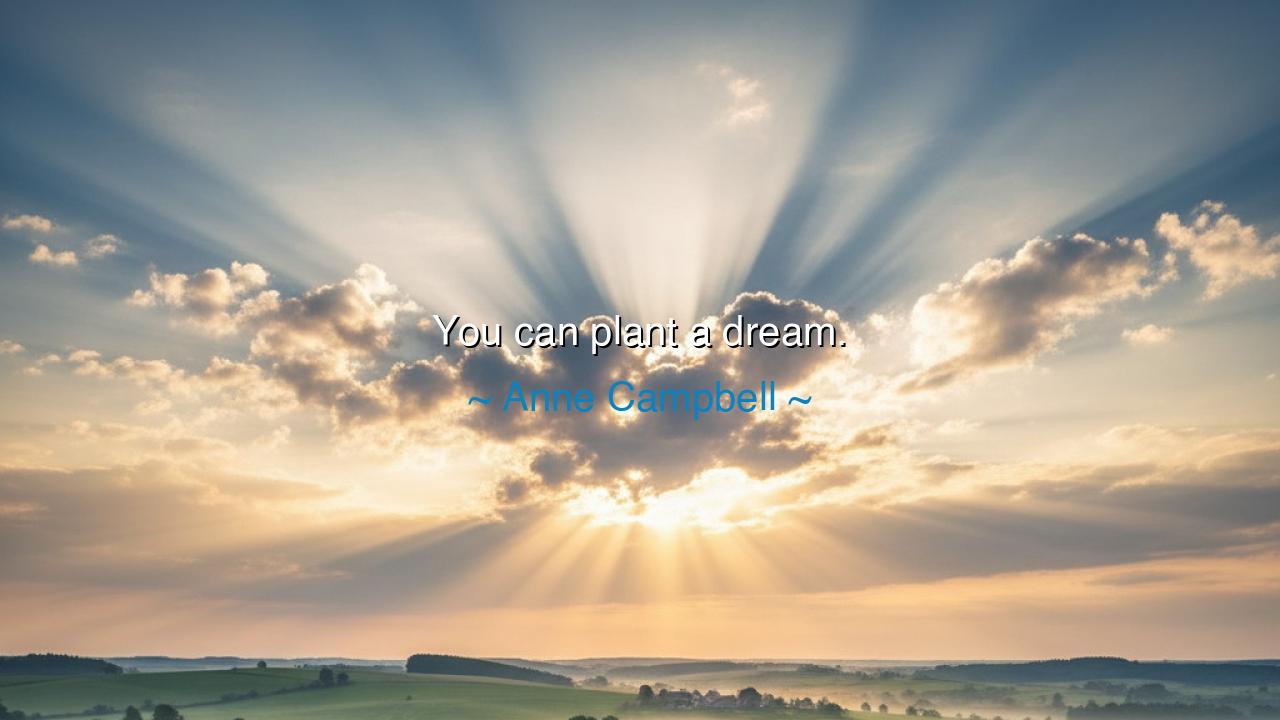
You can plant a dream.






When Anne Campbell whispered the words, “You can plant a dream,” she spoke with the quiet power of one who understands the sacred rhythm between hope and harvest. These simple words are not a command of haste but a hymn of patience. They remind us that a dream, like a seed, is not meant to bloom at once. It must first be planted—buried in the dark soil of uncertainty, tended with faith, and watered with endurance. The dreamer, therefore, is both a visionary and a gardener of the soul.
To plant a dream is to take what is invisible and give it a chance to live in the visible world. Many dream, but few plant. Dreaming is easy; it is the soaring of the mind beyond the reach of the moment. But planting—ah, that requires courage. To plant is to commit, to say: “I believe in this vision enough to labor for it.” Just as the farmer cannot expect fruit without toil, neither can the dreamer expect triumph without effort. The dream must be given roots before it can grow wings.
The ancients understood this truth well. They spoke of faith as the seed of destiny. The farmer who sows in the barren earth does not despair because he sees only dust—he trusts the hidden miracle of growth. So too must we trust the unseen workings of our dreams. When Anne Campbell wrote her tender line, she was not speaking merely of imagination but of action—the transformation of desire into doing, and of thought into becoming. To plant a dream is to begin the sacred dialogue between the heart and time itself.
Consider the story of Nelson Mandela, who, in the long darkness of his imprisonment, planted a dream of freedom for his people. For twenty-seven years, that dream lay hidden like a seed beneath the weight of stone walls and iron bars. Yet he did not let despair uproot it. He watered it with patience, tended it with forgiveness, and shielded it with hope. When the season was right, that buried dream broke the surface of the world—and South Africa blossomed into a new dawn. His life teaches us that the planting is not the end, but the beginning of a quiet revolution.
To plant a dream is also to accept that not all seeds grow quickly. Some require years of quiet tending before they rise. The impatient dig up their hopes to see if they are growing, and thus destroy them. But the wise let time do its silent work. They trust that what they have planted in sincerity will one day bloom in beauty. This is the way of all creation: the oak begins as an acorn; the song begins as a whisper; the dream begins as a fragile thought, barely daring to exist. Yet from such small beginnings come the mighty works of humanity.
The meaning of Campbell’s quote, then, is both tender and powerful: that every soul holds the capacity to create, to begin, to bring forth something greater than itself. To plant a dream is to engage in the divine act of co-creation with life. It is to say to the universe, “Here, I will add my vision to your unfolding.” But this act demands faith, perseverance, and love—qualities that root the dream deeply enough to survive the storms of doubt and the droughts of discouragement.
The lesson is clear, my child: do not merely dream—plant. Write your vision down. Speak it aloud. Begin the work, however small, that will give it life. Tend to it each day, and protect it from the weeds of fear and the frost of cynicism. Be patient with your dream, for every great harvest takes its season. Remember, the earth never mocks the seed; it only waits for the sower’s faith.
So go forth as a gardener of possibility. Plant your dreams not in the shallow soil of wishful thinking, but in the deep ground of action and hope. Nurture them with persistence, and let the rains of challenge strengthen their roots. In time, they will rise toward the light—and when they bloom, the world will remember that you once believed enough to plant.






AAdministratorAdministrator
Welcome, honored guests. Please leave a comment, we will respond soon